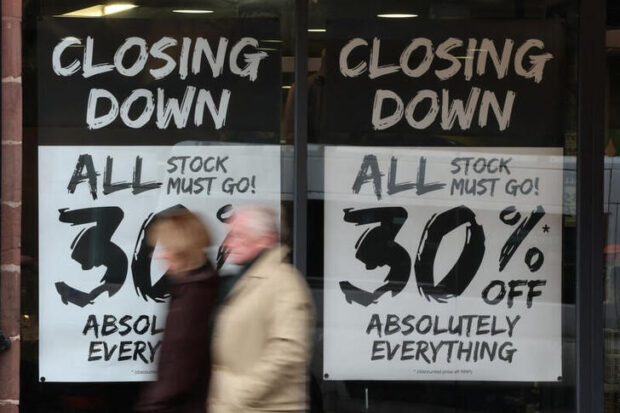
People walk past a shop with closing down signs in the window in Chester, Britain, Nov 17, 2022. REUTERS/Phil Noble/File photo
LONDON – England and Wales are on track for the highest quarterly number of company insolvencies since early 2009, as businesses struggle to repay COVID-19 loans against a tough economic backdrop, government figures showed on Tuesday.
The Insolvency Service, a government agency, said 2,163 companies were declared insolvent in June, up 27 percent on a year earlier although down from May’s 2,553, which was the highest since monthly records began in January 2019.
Over the three months to the end of June, there were 6,403 companies declared insolvent. If this figure is confirmed when official quarterly numbers are published later this month, it would be the highest non-seasonally-adjusted calendar-quarter total since the first quarter of 2009.
“The monthly figures confirm what we are seeing on the ground – that UK corporates are struggling to cope with a challenging combination of rising interest rates, sticky inflation, higher wage expectations whilst recovering from a hangover of Covid debt,” said Gareth Harris, a partner at RSM UK Restructuring Advisory.
As usual, most company insolvencies were creditors’ voluntary liquidations – where company directors and creditors agree to wind up a company without a formal court order.
There were 260 compulsory liquidations in June, 77 percent more than a year earlier, which the Insolvency Service said partly reflected more winding-up petitions for unpaid taxes.
However, RSM said it expected the number of insolvencies to fall by more than 10 percent by the end of this year, despite rising Bank of England interest rates which financial markets expect to reach 6 percent by November, the highest since 2001.
“The drop is likely to come mainly from a fall in ‘shut down’ Creditors’ Voluntary Liquidations where the catch-up from low points of Covid and Government support will largely be flushed out,” Harris said.
Britain’s government lent businesses 80 billion pounds during the pandemic and put a temporary hold on many debt proceedings, which only fully ended in April 2022.